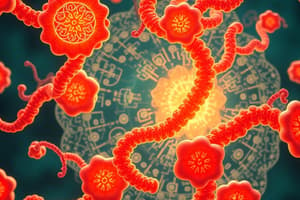Podcast
Questions and Answers
What are the three major components of eukaryotic cells?
What are the three major components of eukaryotic cells?
Cell membranes, cytoplasm, nucleus
What is the outer cell membrane called?
What is the outer cell membrane called?
Plasma membrane
The plasma membrane separates the interior of the cell from the _______.
The plasma membrane separates the interior of the cell from the _______.
outside environment
Which of the following are included in lipids found in cell membranes? (Select all that apply)
Which of the following are included in lipids found in cell membranes? (Select all that apply)
Proteins contribute less than 50% of membrane weight.
Proteins contribute less than 50% of membrane weight.
What are integral membrane proteins known for?
What are integral membrane proteins known for?
What type of proteins penetrate the entire membrane and protrude from both sides?
What type of proteins penetrate the entire membrane and protrude from both sides?
What are the three major components of eukaryotic cells?
What are the three major components of eukaryotic cells?
What is the outer cell membrane called?
What is the outer cell membrane called?
The cytoplasm is enclosed by the nucleus.
The cytoplasm is enclosed by the nucleus.
Which of the following lipids is the most abundant form in cell membranes?
Which of the following lipids is the most abundant form in cell membranes?
What type of proteins are tightly lodged in the lipid bilayer?
What type of proteins are tightly lodged in the lipid bilayer?
What do transmembrane proteins form?
What do transmembrane proteins form?
Flashcards are hidden until you start studying
Study Notes
General Properties of Biological Membranes
- Biological membranes separate the cell from its environment and create functional compartments such as the nucleus and organelles.
- The outer membrane for eukaryotic cells is called the plasma membrane or plasmalemma.
- Plasma membranes are present in all cells; bacterial and plant cells additionally possess a cell wall.
Cellular Components
- Eukaryotic cells consist of three main components: plasma membrane, cytoplasm, and a membrane-bound nucleus.
- The cytoplasm surrounds the nucleus, containing structures that translate DNA instructions for cellular activities.
- The nucleus holds DNA and regulates gene expression for protein synthesis.
Lipids in Membrane Structure
- Major lipids in cell membranes include phospholipids, sphingolipids, and cholesterol, with phospholipids being the most abundant.
- Each phospholipid has a hydrophilic (polar) head and hydrophobic (nonpolar) fatty acid tails.
- Membrane phospholipids form a bilayer, orienting their tails inward, creating a hydrophobic core.
Proteins in Membrane Structure
- Membrane proteins can comprise over 50% of the membrane's weight and are classified as integral or peripheral.
- Integral proteins span the lipid bilayer, with hydrophilic amino acids interacting with the membrane's phosphate groups and hydrophobic amino acids interacting with fatty acid tails.
- Transmembrane proteins penetrate the membrane and function as channels or receptors, facilitating the passage of water and solutes.
- Cryofracture techniques reveal membrane structure by splitting membranes at hydrophobic regions, exposing the two sides: P (protoplasmic) face near the cytoplasm and E (ectoplasmic) face facing the external environment.
General Properties of Biological Membranes
- Biological membranes separate the cell from its environment and create functional compartments such as the nucleus and organelles.
- The outer membrane for eukaryotic cells is called the plasma membrane or plasmalemma.
- Plasma membranes are present in all cells; bacterial and plant cells additionally possess a cell wall.
Cellular Components
- Eukaryotic cells consist of three main components: plasma membrane, cytoplasm, and a membrane-bound nucleus.
- The cytoplasm surrounds the nucleus, containing structures that translate DNA instructions for cellular activities.
- The nucleus holds DNA and regulates gene expression for protein synthesis.
Lipids in Membrane Structure
- Major lipids in cell membranes include phospholipids, sphingolipids, and cholesterol, with phospholipids being the most abundant.
- Each phospholipid has a hydrophilic (polar) head and hydrophobic (nonpolar) fatty acid tails.
- Membrane phospholipids form a bilayer, orienting their tails inward, creating a hydrophobic core.
Proteins in Membrane Structure
- Membrane proteins can comprise over 50% of the membrane's weight and are classified as integral or peripheral.
- Integral proteins span the lipid bilayer, with hydrophilic amino acids interacting with the membrane's phosphate groups and hydrophobic amino acids interacting with fatty acid tails.
- Transmembrane proteins penetrate the membrane and function as channels or receptors, facilitating the passage of water and solutes.
- Cryofracture techniques reveal membrane structure by splitting membranes at hydrophobic regions, exposing the two sides: P (protoplasmic) face near the cytoplasm and E (ectoplasmic) face facing the external environment.
Studying That Suits You
Use AI to generate personalized quizzes and flashcards to suit your learning preferences.




